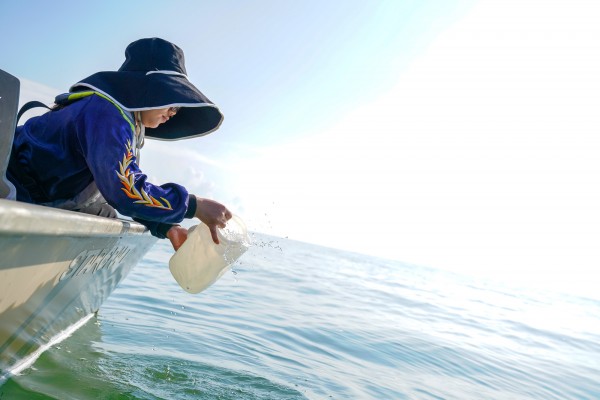 Eight research vessels from the University of Windsor participated in the Harmful Algal Blooms Grab on Wednesday, Aug. 7, 2019. Scientists from the United States and Canada collected water samples to study the environmental stimuli responsible for toxic production by the harmful algal blooms.
Eight research vessels from the University of Windsor participated in the Harmful Algal Blooms Grab on Wednesday, Aug. 7, 2019. Scientists from the United States and Canada collected water samples to study the environmental stimuli responsible for toxic production by the harmful algal blooms.
Scientists from UWindsor’s Great Lakes Institute for Environmental Research fanned out across western Lake Erie Wednesday as part of a binational project to assess the danger posed by this summer’s algal bloom.
It’s the first time Canadian researchers have participated in the one-day project that involves collecting water samples from 175 locations over four hours. Called the HABs Grab ─ HAB is short for harmful algal bloom ─ the project has nearly doubled in scope this year with the participation of the University of Windsor, Environment and Climate Change Canada and Canada’s federal Department of Fisheries and Oceans.
A goal of the project is to estimate the amount and types of microcystins contained in the blue-green algae that blooms in Lake Erie at this time of year. Microcystins are a class of liver toxins produced by cyanobacteria that make up the bloom. The toxins can be harmful to humans, pets and wildlife, threatening drinking water supplies.
“We’re trying to uncover the environmental stimuli responsible for toxin production by the harmful algal blooms that have plagued Lake Erie in recent years,” GLIER executive director Mike McKay, who is co-ordinating the Canadian arm of the project.
McKay, who was on faculty at Bowling Green State University in Ohio before joining GLIER earlier this year and is still the research co-ordinator of Bowling Green’s Great Lakes Centre for Fresh Waters and Human Health, helped co-ordinate the activities of more than 30 scientists on eight research vessels Wednesday.
The researchers collected 60 samples from pre-selected co-ordinates on the Canadian side of the lake. The samples will be processed at GLIER, then sent to labs in Michigan and Ohio for analysis.
GLIER researchers confirmed satellite images that show a bloom stretching up to 1,300 square kilometres extending through the lake’s western basin. The epicentre is near Toledo, with tentacles that stretch toward the shores of Colchester in Essex.
#YQG reporting for duty. @GLIERUWINDSOR @ScienceUWindsor RV Loon on the water at #Colchester Harbour and heading to first coordinates for #habsgrab19 pic.twitter.com/Rb84wtFTvO
— Mike McKay (@McKayGLIER) August 7, 2019
McKay was living in Ohio when the City of Toledo’s water supply was contaminated by microcystins in 2014. Residents had to use bottled water for cooking and bathing.
HABs Grab was borne of that crisis.
“The crisis raised awareness and made more resources available to scientists,” McKay said.
Field work is important to understanding the bloom, he said. “What satellites do not tell us is what’s going on inside the bloom itself.”
Water samples will allow researchers to measure toxin levels, develop toxin profiles, and measure the nutrient levels feeding them.
Lake Erie’s western basin is the perfect breeding ground for algal blooms, McKay said. The water is shallow, allowing it to be warmed faster than other parts of the lake. Nutrients flow into the lake from the high population density and agricultural lands that surround it.
McKay said Ohio residents can see evidence of the algal bloom on their beaches. On this side of the border, the bloom is further offshore, making Wednesday’s water sampling important.
“Without this, in Ontario, it’s out of sight, out of mind.”
─ Sarah Sacheli
